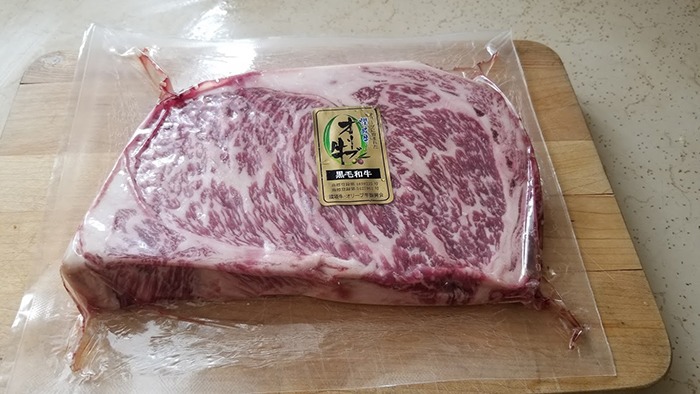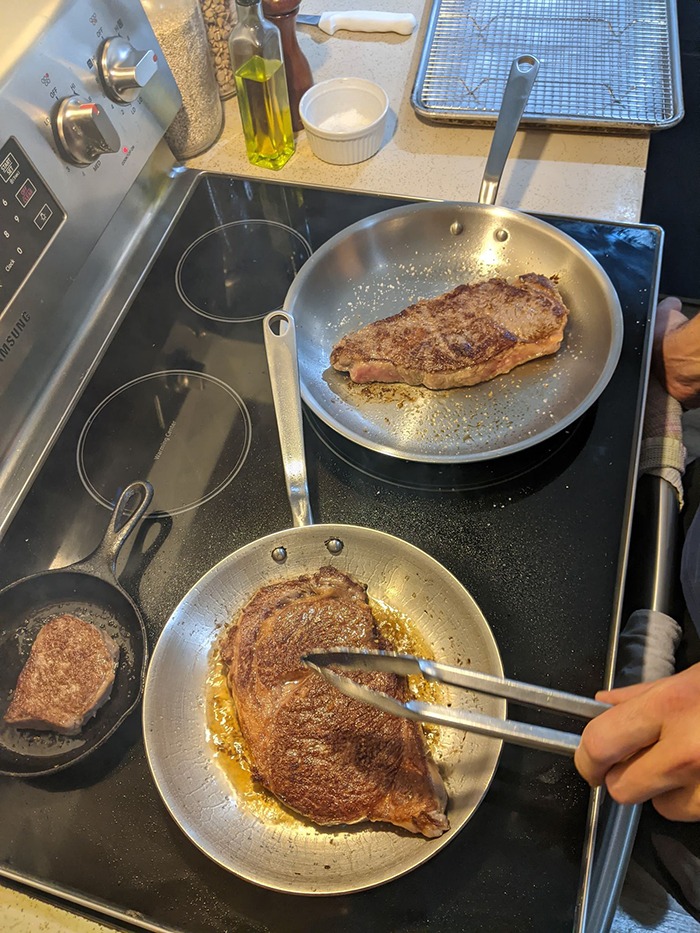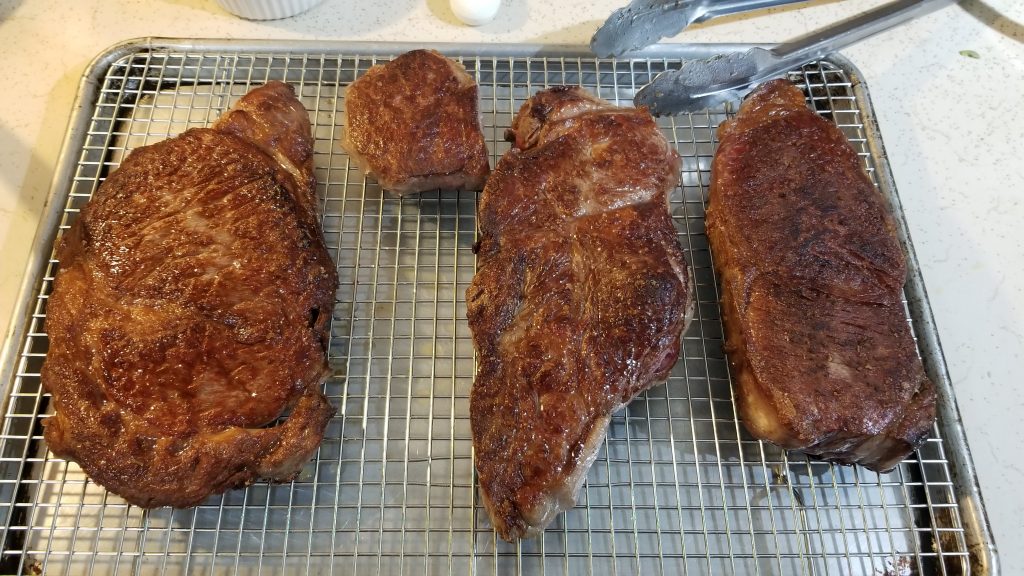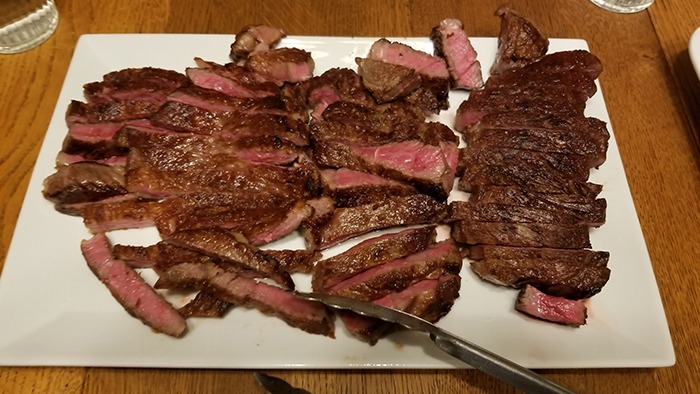How A5 Wagyu Beef Should Be Cooked
I get it. You just spent a ton of money on a nice Japanese A5 Wagyu steak and you don't want to screw it up. For most people a nice Wagyu steak will be the most expensive piece of meat they will ever eat and ruining it would be devastating. Luckily cooking a Japanese A5 Wagyu steak isn't complicated. In this post I will show you how to cook a Japanese A5 Wagyu steak and cook it with confidence.
What is Japanese A5 Wagyu Steak?
I won't go into all the details but wanted to give you some basic info on Wagyu. Wagyu basically means "Japanese Cow". More specifically when you are talking Japanese A5 Wagyu steaks you are talking about Japanese Black Cattle. These cows have some amazing genetics that produce some incredible intramuscular fat (aka marbling). These cows are also raised and fed much differently than American cattle.

Disclosure: This post is monetized with affiliate links. If you buy something through them I earn a commission which helps support this site and lets me buy more meat so I can write about it.
Above is a great example of a wagyu steak. That one is an olive fed NY strip from Pursuit Farms and is one of the steaks I will show you how to cook.
A couple more quick bullet points about A5 Wagyu before we get cooking:
- Yes, real Japanese A5 Wagyu is very expensive. It isn't uncommon for a single steak (like the one above) to cost $250 or more.
- You need to know where to buy Japanese A5 Wagyu beef. These aren't steaks you can just get at your local grocery store. Ordering online is your best bet.
- The "A" in A5 refers to the yield of the cow and the "5" refers to the amount of marbling. A5 is the best of the best but A4 or even A3 steaks can be fabulous as well.
- Not all Japanese Wagyu is created equal. You will see some brands like Miyazaki or Kagoshima. Those are good but brands like Kobe, Ohmi, and Hokkaido Snow are better. You can find those three brands available at Pursuit Farms.
OK, let's get cooking!
How to cook Japanese A5 Wagyu Steak
There are a few generally accepted methods to cook a Japanese Wagyu steak. I will talk about the way I cooked mine and then give you a couple other options. All these options are cooked in a pan. Don't fire up the grill for these steaks. There is way too much fat in these steaks that will render out, hit the coals, and cause flareups which leads to nasty soot and bad flavors. Stick with a good pan on your stove. Or if you really want to cook outside put a pan or flat top of some sort on your grill.
Let's talk pans. Stainless steel or carbon steel are the preferred pans for cooking Japanese A5 Wagyu. Cast iron can work (and I did use a small cast iron pan for one of mine) but stainless steel and carbon steel are more responsive. They can heat up or cool down quicker than cast iron. I used a couple stainless steel skillets from Made In Cookware which I love.

Here are the three steaks I cooked. On the left is a Miyazaki filet a friend shipped from Cote Korean Steakhouse in NYC. In the middle is an Ohmi strip and on the right is an olive fed strip. The Ohmi and olive fed steaks were from Pursuit Farms. I also had an Australian Wagyu strip from Pursuit that I reverse seared. Just wanted to mention that one because you might see it in some of the pictures.
If you have some thicker steaks like these ones (the strips were 1 lb each) you will want to let them rest at room temperature for 15-30 minutes. For thinner steaks just cook them straight out of the fridge. Many Japanese wagyu steaks are on the thinner side.
For seasoning you don't need anything other than some kosher salt. Maybe you can use a bit of pepper but I don't think it is necessary. Just a healthy sprinkle of salt will do the trick.
What we are looking for with steaks like these is a nice sear on the outside and medium rare or even the high end of medium rare on the inside. Depending on the steak you will want to shoot for 125-130 degrees. If it goes to 135 or even 140 you will still be fine. I wouldn't do rare on a steak like this though. You want the interior fat to melt.
Let's get these steaks in the pan!
Get your pans heated up over medium heat. If you have really thin steaks bump the temperature up a bit. You want enough heat to get a good sear on the steak but you don't want the outside burnt before the inside is up to temperature.
No need for any oil or fat for these steaks. There is enough fat that will render out of these steaks so no need to add oil. If you really want to use some oil use some oil with a super high smoke point like safflower oil. But I would just skip it all together. And don't bother butter basting these steaks. Again, there is plenty of fat in these steaks.
Give the steaks a sprinkle of salt and lay them in the heated pan salt side down. Then give the top of the steak a sprinkle. I like to flip my steaks every 20-30 seconds for a couple reasons.
- When you have a steak on a hot pan the side that is touching the pan is getting loaded up with heat. That heat pushes into the middle of the steak. When you flip the steak a lot of that heat will dissipate out of the steak and not go into the middle of it. As you keep flipping you will get a great sear on the outside without the middle overcooking.
- There is more margin for error. How horrible would it be to cook the steak for 2-3 minutes on one side, flip it, and see that side burnt? Or have the middle of the steak at 130 degrees before you have a chance to sear the other side? By flipping every 20-30 seconds you can see what is happening on both sides of the steak regularly. As a result you can gauge if one side needs more cooking or if you need to adjust the temperature.

This is what the steak looks like after a couple flips. Not too appetizing yet, is it? But be patient. Keep flipping and after 2-3 minutes you will start to see a great crust form over the whole steak. If you have done everything right the exterior of the steak will have a nice, brown crust right when the middle of the steak hits your target temperature. You have been checking your temps with your instant read thermometer, right? I like the Thermopop from Thermoworks. You definitely don't want to ruin a $200+ steak so spend the $39 and get a good thermometer.

The olive fed ribeye (the bottom of this picture) is almost done here. You can see the great brown crust that was forming on this steak. You can also see how much fat has rendered out into the pan. All in all it will probably take somewhere between 3-5 minutes depending on how thick your steaks are, how hot your pan is, etc.
Be warned, you will want to open your windows and turn on a fan before cooking. There WILL be a lot of smoke and chances are you will set off your smoke detector. And you will get a lot of splatter on your stove as evidenced in the picture above.

This is what you are looking for on your Japanese A5 Wagyu steaks. These steaks all had a great crust on them and were almost a perfect medium rare in the middle. I probably could have gone a couple more degrees hotter on these but they were still excellent. It was my first time experimenting with how to cook Japanese A5 Wagyu steaks.
Rest, slice, and eat!
Give the steaks a few minutes to rest. 3-5 minutes should suffice. Since most Japanese A5 Wagyu steaks are on the thin side there won't be a ton of carryover heat. The rest is mostly to let the meat relax a bit and hold on to a bit more of the fat and juice.
With most steaks I like to just slap the thing on a plate and cut it as I eat. But with steaks like this you don't need a giant steak. Most likely you will also be sharing these steaks with a group. So I sliced them up into fairly thin strips and served them.

From left to right are the filet, the olive fed strip, the Ohmi strip, and the Australian Wagyu strip. I know the plating there isn't worthy of steaks this wonderful but give me a break. I was hungry and in a hurry to get this meat on the table for our guests.
You don't need to eat 20 ozs of this type of steak like you might with a regular ribeye. 4 or 5 ozs per person is plenty. This beef is so rich and so fatty that if you eat it like you would a normal steak you will most likely have quite the stomach ache later.
Out of all these steaks I preferred the olive fed steak. It had a great sweet flavor and amazing texture. The Ohmi steak had a great beefy flavor (more so than I was expecting). I thought the Australian strip was one of the best "regular" strips I have ever had. The Miyazaki tenderloin didn't really hold up next to the other higher quality Japanese steaks. It was still delicious and if I didn't have the other two to compare it to I am sure it would have seemed amazing.
So that's it as far as how to cook a Japanese A5 Wagyu steak. The process is very simple overall. Keep it simple and just give the steaks a quick pan sear. It can be kind of intimidating to look down on your stove and see $500+ worth of steaks in the pan. But cook confidently. Use your eyes, ears, and nose to discern what is going on. And of course a good thermometer helps.
If you are more of a visual learner here is a video I shot of the cooking process:
Other ways to cook Japanese A5 Wagyu Steak
So you didn't learn how to cook a Japanese A5 Wagyu steak above? OK, here are a couple acceptable alternatives:
Cut the steaks in to about 1 inch strips and sear those off in a pan rather than the whole steak. Sear all 4 sides of the strips. The result will be some great, crusty strips of beefy, fatty heaven.
If you have a thicker block of meat (over an inch thick) you can also slice very thin strips and cook them for just a few seconds on either side. Eat them as the come off the pan. They are so thin that they would get cold by the time you got them all cooked and to to the table.
The two methods above are common ways of cooking these steaks in Japan. Rather than slapping a giant slab of beef on a plate like we do in America they just eat a couple small pieces of steak on rice or vegetables.
If you want to learn a bit more about Wagyu beef Adam Ragusea just published a video with some good information:
His video is sponsored by Crowd Cow which does sell real Japanese A5 Wagyu beef. They primarily sell Kagoshima beef which isn't quite the same quality as the higher end Japanese A5 Wagyu you can get at Pursuit Farms.
And listen, I know these steaks are expensive. These aren't the type of steaks you will eat every week, month, or even year. Got a bachelor party? Pick up a few different types of Wagyu steaks and have a tasting. 50th birthday? 40th anniversary? Big promotion at work? A special gift for a friends first baby? Want to give a big thanks to a client? Those are the types of occasions to splurge and drop a few hundred bucks on a once in a lifetime type of steak.
So now that you know how to cook Japanese A5 Wagyu steaks what are you waiting for? Order some steaks from Pursuit Farms (did I mention they ship all their steaks fresh and not frozen?), get a good pan, and cook.
brooksbeggersewen.blogspot.com
Source: https://completecarnivore.com/how-to-cook-a-japanese-a5-wagyu-steak/
0 Response to "How A5 Wagyu Beef Should Be Cooked"
Post a Comment